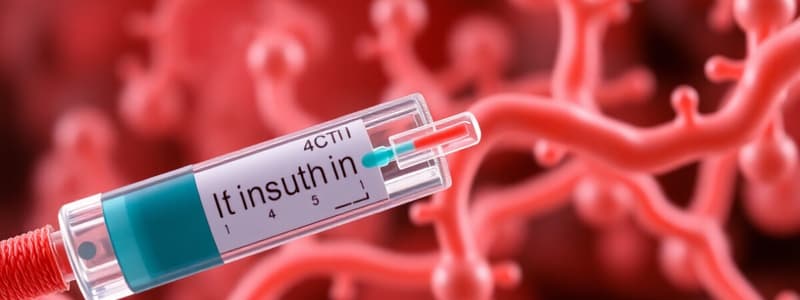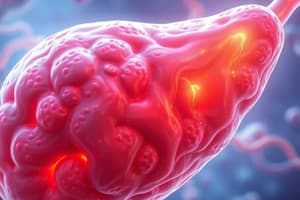Podcast
Questions and Answers
What is the primary effect of insulin on blood glucose levels?
What is the primary effect of insulin on blood glucose levels?
- It has no significant effect on blood glucose levels.
- It decreases blood glucose levels. (correct)
- It maintains blood glucose levels at a constant rate.
- It increases blood glucose levels.
Which of the following hormones primarily facilitates the conversion of glucose to glycogen in the liver?
Which of the following hormones primarily facilitates the conversion of glucose to glycogen in the liver?
- Insulin (correct)
- Cortisol
- Glucagon
- Epinephrine
What is the role of GSK3 in the context of insulin action?
What is the role of GSK3 in the context of insulin action?
- It stimulates gluconeogenesis in the liver.
- It promotes the breakdown of glycogen.
- It regulates hepatic glycogen synthesis. (correct)
- It enhances glucose uptake by muscle cells.
Which molecular mechanism does insulin utilize to mediate glucose uptake in adipose tissue?
Which molecular mechanism does insulin utilize to mediate glucose uptake in adipose tissue?
In what way does insulin affect gluconeogenesis?
In what way does insulin affect gluconeogenesis?
Which of the following statements about insulin's physiological actions is false?
Which of the following statements about insulin's physiological actions is false?
Which of the following is NOT a direct action of insulin on cellular metabolism?
Which of the following is NOT a direct action of insulin on cellular metabolism?
What is the primary action of insulin in the liver regarding glucose metabolism?
What is the primary action of insulin in the liver regarding glucose metabolism?
Which enzyme is associated with the prevention of futile cycling in gluconeogenesis?
Which enzyme is associated with the prevention of futile cycling in gluconeogenesis?
How does glucagon affect the PFK2/FBPase-2 enzyme system?
How does glucagon affect the PFK2/FBPase-2 enzyme system?
What role does malonyl CoA play in fatty acid metabolism?
What role does malonyl CoA play in fatty acid metabolism?
In the context of insulin's effect, which process is suppressed in the adipose tissue?
In the context of insulin's effect, which process is suppressed in the adipose tissue?
Which substrate is essential for the action of PEPCK in gluconeogenesis?
Which substrate is essential for the action of PEPCK in gluconeogenesis?
What metabolic pathway is primarily promoted by insulin in relation to fatty acids?
What metabolic pathway is primarily promoted by insulin in relation to fatty acids?
Which condition is likely caused by dysregulation of lipoprotein transport mechanisms in diabetes?
Which condition is likely caused by dysregulation of lipoprotein transport mechanisms in diabetes?
Which of the following enzyme activities is associated with insulin's promotion of glucose uptake into the liver?
Which of the following enzyme activities is associated with insulin's promotion of glucose uptake into the liver?
What triggers the secretion of glucagon?
What triggers the secretion of glucagon?
Which process is stimulated by glucagon in the liver?
Which process is stimulated by glucagon in the liver?
What is the primary role of insulin in blood glucose regulation?
What is the primary role of insulin in blood glucose regulation?
How does glucagon affect fatty acid oxidation in adipose tissues?
How does glucagon affect fatty acid oxidation in adipose tissues?
What is the normal range for blood glucose levels in mmols/l?
What is the normal range for blood glucose levels in mmols/l?
What is one of the main actions of glucagon regarding glycogen?
What is one of the main actions of glucagon regarding glycogen?
Which of the following is NOT a function of glucagon?
Which of the following is NOT a function of glucagon?
What is the secondary messenger associated with glucagon action?
What is the secondary messenger associated with glucagon action?
Which statement accurately describes the relationship between insulin and glucagon?
Which statement accurately describes the relationship between insulin and glucagon?
Which hormone acts as a first-line response in counter-regulatory mechanisms?
Which hormone acts as a first-line response in counter-regulatory mechanisms?
What is characteristic of type 1 diabetes in comparison to type 2 diabetes?
What is characteristic of type 1 diabetes in comparison to type 2 diabetes?
According to the WHO criteria, what fasting plasma glucose (FPG) level indicates diabetes?
According to the WHO criteria, what fasting plasma glucose (FPG) level indicates diabetes?
What factor can influence HbA1c results and is particularly problematic in under-resourced countries?
What factor can influence HbA1c results and is particularly problematic in under-resourced countries?
Which classification of diabetes includes cases where a person is diagnosed by exclusion of type 1 diabetes and other conditions?
Which classification of diabetes includes cases where a person is diagnosed by exclusion of type 1 diabetes and other conditions?
What is the criteria for pre-diabetes based on HbA1c levels according to the ADA?
What is the criteria for pre-diabetes based on HbA1c levels according to the ADA?
What is the major feature of diabetes mellitus?
What is the major feature of diabetes mellitus?
What condition can result from glucosuria in individuals with diabetes?
What condition can result from glucosuria in individuals with diabetes?
What was a common dietary treatment for diabetes mellitus before insulin became available?
What was a common dietary treatment for diabetes mellitus before insulin became available?
What severe outcome is associated with untreated diabetes mellitus in children, as illustrated in the content?
What severe outcome is associated with untreated diabetes mellitus in children, as illustrated in the content?
What was a consequence of the high extracellular glucose observed after meals in individuals with diabetes?
What was a consequence of the high extracellular glucose observed after meals in individuals with diabetes?
What did the content describe one child resorting to due to starvation from diabetes?
What did the content describe one child resorting to due to starvation from diabetes?
Which of the following is NOT a risk factor mentioned for children with diabetes before insulin was discovered?
Which of the following is NOT a risk factor mentioned for children with diabetes before insulin was discovered?
What does the presence of glucose in urine signify in a diabetic patient?
What does the presence of glucose in urine signify in a diabetic patient?
What philosophical remark did the physician Allen make regarding the child's situation?
What philosophical remark did the physician Allen make regarding the child's situation?
Which of these complications is highlighted as a potential consequence of untreated diabetes mellitus?
Which of these complications is highlighted as a potential consequence of untreated diabetes mellitus?
Flashcards
Insulin action on liver
Insulin action on liver
Insulin promotes glycogen synthesis (storing glucose) and suppresses gluconeogenesis (making glucose).
Insulin action on adipose tissue
Insulin action on adipose tissue
Insulin promotes glucose uptake and fat storage in adipose tissue.
Blood glucose homeostasis
Blood glucose homeostasis
Maintaining normal blood glucose levels (3.9-5.9 mmol/L).
Insulin's role in glycogen synthesis
Insulin's role in glycogen synthesis
Signup and view all the flashcards
Gluconeogenesis
Gluconeogenesis
Signup and view all the flashcards
Insulin's role in glucose uptake
Insulin's role in glucose uptake
Signup and view all the flashcards
Insulin signaling pathway
Insulin signaling pathway
Signup and view all the flashcards
PEPCK
PEPCK
Signup and view all the flashcards
Gluconeogenesis
Gluconeogenesis
Signup and view all the flashcards
Glycolysis
Glycolysis
Signup and view all the flashcards
Insulin
Insulin
Signup and view all the flashcards
Glucagon
Glucagon
Signup and view all the flashcards
Futile cycling
Futile cycling
Signup and view all the flashcards
VLDL
VLDL
Signup and view all the flashcards
Fatty acid synthesis
Fatty acid synthesis
Signup and view all the flashcards
Hyperlipidemia
Hyperlipidemia
Signup and view all the flashcards
Diabetes Mellitus
Diabetes Mellitus
Signup and view all the flashcards
Hyperglycemia
Hyperglycemia
Signup and view all the flashcards
Glucosuria
Glucosuria
Signup and view all the flashcards
Osmotic Diuresis
Osmotic Diuresis
Signup and view all the flashcards
Pre-Insulin Treatments
Pre-Insulin Treatments
Signup and view all the flashcards
Blood Glucose levels
Blood Glucose levels
Signup and view all the flashcards
Glucose Uptake
Glucose Uptake
Signup and view all the flashcards
Dietary Treatments
Dietary Treatments
Signup and view all the flashcards
Circulatory Failure
Circulatory Failure
Signup and view all the flashcards
Renal Failure
Renal Failure
Signup and view all the flashcards
Counterregulation
Counterregulation
Signup and view all the flashcards
Blood Glucose Homeostasis
Blood Glucose Homeostasis
Signup and view all the flashcards
Glucagon's Action
Glucagon's Action
Signup and view all the flashcards
Glycogenolysis
Glycogenolysis
Signup and view all the flashcards
Gluconeogenesis
Gluconeogenesis
Signup and view all the flashcards
Insulin
Insulin
Signup and view all the flashcards
Normal Blood Glucose Range
Normal Blood Glucose Range
Signup and view all the flashcards
Glycogen Synthesis
Glycogen Synthesis
Signup and view all the flashcards
Counter-Regulatory Responses
Counter-Regulatory Responses
Signup and view all the flashcards
Insulin Effect on Blood Sugar
Insulin Effect on Blood Sugar
Signup and view all the flashcards
Type 1 Diabetes (T1DM)
Type 1 Diabetes (T1DM)
Signup and view all the flashcards
Type 2 Diabetes (T2DM)
Type 2 Diabetes (T2DM)
Signup and view all the flashcards
WHO Diabetes Criteria
WHO Diabetes Criteria
Signup and view all the flashcards
HbA1c
HbA1c
Signup and view all the flashcards
Diagnosis of Diabetes (ADA)
Diagnosis of Diabetes (ADA)
Signup and view all the flashcards
Study Notes
Insulin Action on Liver and Adipose Tissues
- Normal blood glucose levels are 3.9-5.9 mmol/L
- Insulin promotes glucose uptake into cells
- Insulin stimulates glycogen synthesis in the liver and skeletal muscle
- Insulin inhibits glycogenolysis in the liver
- Insulin inhibits gluconeogenesis
- Insulin promotes glucose conversion to fatty acids that are then transported to adipose tissue for storage
- Insulin suppresses triglyceride breakdown in adipose tissue
- Insulin treatment can lead to weight gain
Insulin Signaling Pathway
- Insulin binds to its receptor on the cell membrane
- This triggers a cascade of phosphorylation events involving IRS, PI3K, p85, p110, PDK1, mTORC2, and Akt
- The cascade leads to the activation of Akt
- Akt regulates proteins involved in glycogen synthesis, inhibition of gluconeogenesis, and GLUT4 translocation
- Akt also affects proteins involved in protein translation to further affect the process of gluconeogenesis
- GSK3 regulates hepatic glycogen synthesis
- FOXO regulates hepatic gluconeogenesis
Physiological Actions of Insulin
- Insulin promotes glucose uptake into cells
- Insulin promotes glycogen formation in skeletal muscle and liver
- Insulin inhibits glycogen breakdown to glucose (glycogenolysis)
- Insulin inhibits the formation of glucose from non-carbohydrate substances (gluconeogenesis)
Counterregulation
- Counterregulatory hormones like glucagon oppose the effects of insulin.
- Glucagon increases glycogenolysis and gluconeogenesis
- Glucagon suppresses glycolysis
- Glucagon increases fatty acid oxidation
- Glucagon stimulates HSL in adipose tissue
Diabetes Mellitus
- Diabetes is characterized by high blood glucose levels.
- Major feature: Hyperglycaemia (>200 mg/100 mL, >16 mmol/L)
- Glucosuria: Glucose in urine
- Dehydration and circulatory failure may occur due to the large osmotic diuresis
- Following a meal, cells may fail to properly absorb glucose.
- Extracellular glucose levels increase, while intracellular glucose levels decrease
- Before insulin, treatments for diabetes included starvation diets.
Types of Diabetes
- Type 1 Diabetes Mellitus: Pancreatic beta cell destruction; insulin is required for survival. Characterized by the presence of anti-GAD or anti-islet cell antibodies.
- Type 2 Diabetes Mellitus: A diagnosis of exclusion. A person is considered to have Type 2 diabetes if they do not have Type 1 diabetes, monogenic diabetes, or another medical condition suggesting secondary diabetes. Insulin resistance is a common feature.
- MODY: Monogenic diabetes
- Secondary causes, such as drugs, pancreatic issues, or endocrine problems.
Criteria for Diabetes
-
WHO criteria for diabetes:
- Fasting plasma glucose (FPG) ≥ 7.0 mmol/L
- Oral glucose tolerance test (OGTT) 2-hour glucose ≥ 11.1 mmol/L after a 75g glucose load
- Impaired glucose tolerance (IGT): FPG < 7.0 mmol/L but 2-hour OGTT ≥ 7.8 mmol/L, but <11.1 mmol/L
- Impaired fasting glucose (IFG): FPG between 6.1 and 7.0 mmol/L
-
ADA criteria for diabetes diagnosis: HbA1c > 6.5%
-
Pre-diabetes: HbA1c 5.7-6.4%
Other important factors
- The HbA1c result is influenced by factors including anaemia, haemoglobin abnormalities, pregnancy, and uraemia.
- Dysregulation of lipoprotein (VLDL) and fatty acid transport between liver and adipose tissues may occur in diabetes, leading to hyperlipidaemia.
Studying That Suits You
Use AI to generate personalized quizzes and flashcards to suit your learning preferences.
Related Documents
Description
This quiz explores the role of insulin in regulating blood glucose levels and its impact on liver and adipose tissues. It covers insulin signaling pathways and mechanisms such as glycogen synthesis and fat storage. Test your understanding of these crucial metabolic processes!



